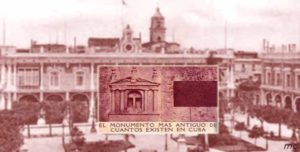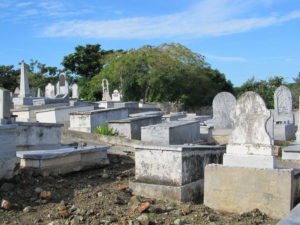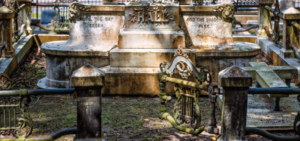 ENCONTRADA EN CUBA EL PRIMER MONUMENTO FUNERARIO DE LA ISLA.
ENCONTRADA EN CUBA EL PRIMER MONUMENTO FUNERARIO DE LA ISLA.
En la Parroquial Mayor de la Villa de San Cristobal de la Habana se encontró el primer monumento funerario de Cuba que data de 1557. Una pequeña lápida de piedra con una cruz y un querubín, con otras diversas alegorías bélicas y funerarias erigida a doña María de Cepero, muerta en 1557 por un disparo de arcabuz, se considera el primer monumento funerario de Cuba.
Doña María de Cepero y Nieto, pertenecía a una de las familias principales de La Habana, señorita importante de la villa de La Habana, hija de don Francisco Cepero, uno de los primeros conquistadores de Cuba, y de doña Isabel Nieto.
La Parroquial Mayor, primera iglesia construida en la Villa San Cristóbal, estaba situada, al cruzar la calle de donde vivía tan distinguida familia, en la esquina de Obispo y Oficios, en la casa donde hoy se encuentra un restaurante.
La primitiva iglesia de La Habana era un mísero bohío sus paredes eran de tierra y los arcos y columnas de piedra, ubicada aproximadamente, en el terreno del antiguo Palacio de los Capitanes Generales. En ella se rindió culto a San Cristóbal, patrón de la ciudad.
Doña María fue herida mortalmente de un casual disparo de arcabuz, mientras rezaba en la Parroquial Mayor asistiendo a una fiesta religiosa que ella había organizado y allí en el mismo lugar donde, según la tradición, cayó mortalmente herida, en 1557 se le erigió un sencillo monumento. Pero este monumento tiene el valor extraordinario de ser el más antiguo de los monumentos existentes en Cuba.
Al pie de ese monumento aparece la siguiente inscripción latina: “HIC FINEM FECIT TORMENTO BELLICO YNOPINATE PERCUSA D. MARÍA CEPERO. AÑO 1.5.5.7. PR. NR. A.M”.
Esta inscripción, traducida al castellano por el Dr. Favole, dice así: “Casualmente herida por un arma aquí murió Da. Maria Cepero en el año de 1557”.
Al ser demolida la Parroquial Mayor, la tarja estuvo instalada en un muro del Palacio de los Capitanes Generales, después en el patio del hoy Museo de la Ciudad y años más tarde, con las obras de restauración de la calle Obispo, pasó a un muro de la casa de su familia, actualmente el Café restaurante La Mina.
 FOUND IN CUBA ITS FIRST FUNERARY MONUMENT OF THE ISLAND.
FOUND IN CUBA ITS FIRST FUNERARY MONUMENT OF THE ISLAND.
The first funerary monument in Cuba dating from 1557 was found in the Parish Church of Villa de San Cristobal de la Habana. A small stone tablet with a cross and a cherub, with various other war and funeral allegories erected to Doña María de Cepero, killed in 1557 by a gunshot, is considered the first funeral monument in Cuba.
Doña María de Cepero y Nieto, belonged to one of the main families of Havana, important young lady of the town of Havana, daughter of Don Francisco Cepero, one of the first conquerors of Cuba, and of Doña Isabel Nieto.
La Parroquial Mayor, the first church built in Villa San Cristóbal, was located, across the street from where such a distinguished family lived, on the corner of Obispo and Oficios, in the house where a restaurant is located today.
The primitive church of Havana was a miserable bohío, its walls were made of earth and the stone arches and columns, located approximately, in the area of the old Palace of the Captains General. In it, San Cristóbal, patron saint of the city, was worshiped.
Doña María was mortally wounded by a casual shot from a harquebus, while she was praying in the Parroquial Mayor attending a religious party that she had organized and there in the same place where, according to tradition, she was mortally wounded, in 1557 a simple one was erected the monument. But this monument has the extraordinary value of being the oldest of the existing monuments in Cuba.
At the foot of that monument the following Latin inscription appears: “HIC FINEM FECIT TORMENTO BELLICO YNOPINATE PERCUSA D. MARÍA CEPERO. YEAR 1.5.5.7. PR. NR. AM.”
This inscription, translated into Spanish by Dr. Favole, reads as follows: “Coincidentally wounded by a weapon, Da. Maria Cepero died in the year 1557.”
When the Greater Parish Church was demolished, the gate was installed on a wall of the Palace of the Captains General, then in the courtyard of the today City Museum and years later, with the restoration works on Obispo Street, it passed to a wall from his family’s house, currently the Café restaurant La Mina.
Agencies/ RHC/ Maria Calvo/ Internet Photos/ Arnoldo Varona/ www.TheCubanHistory.com
THE CUBAN HISTORY, HOLLYWOOD.







